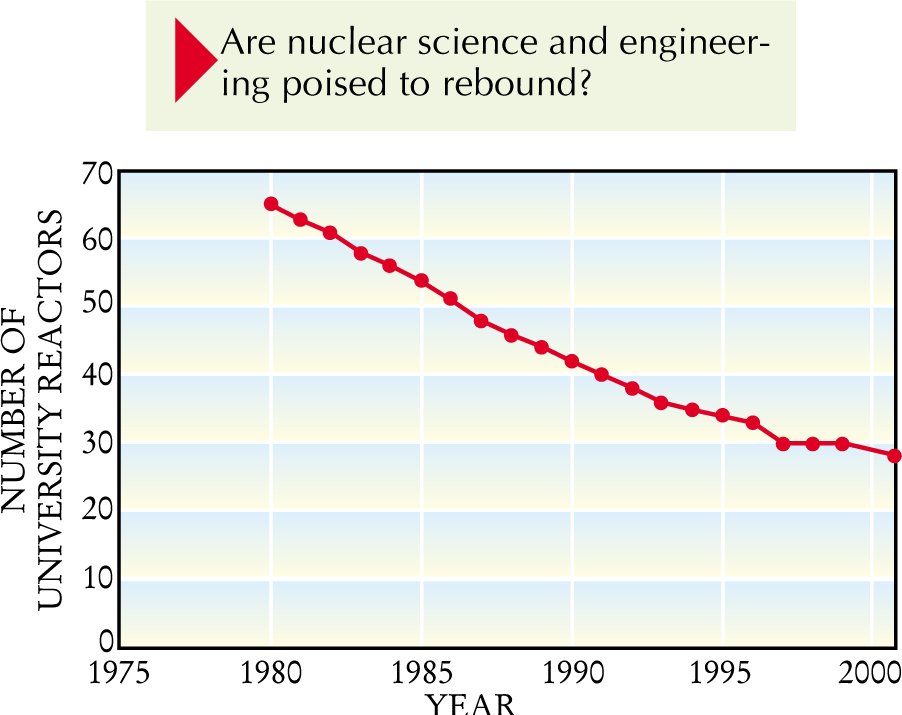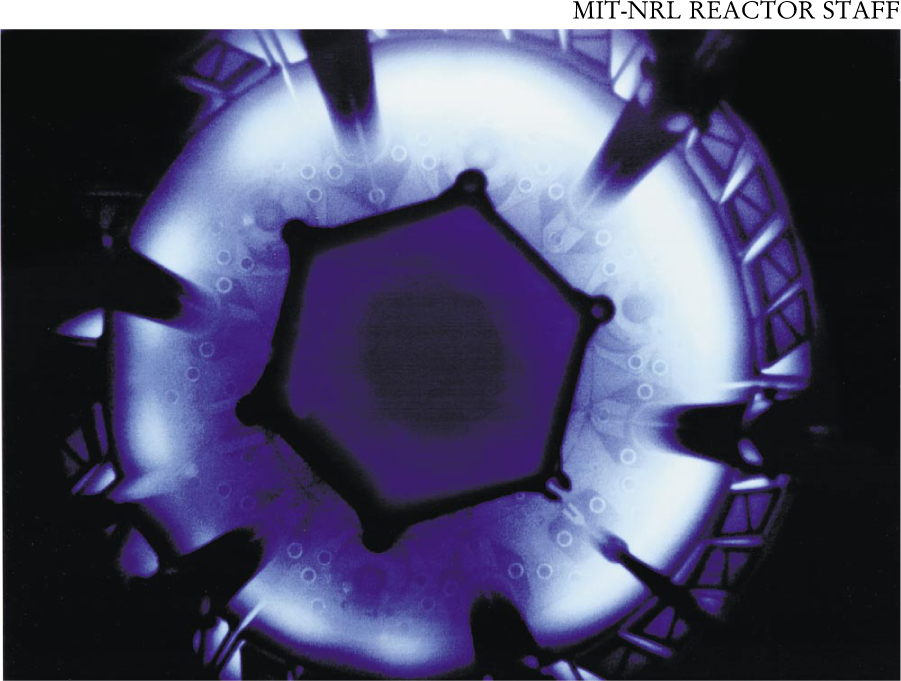University Research Reactors Compete for DOE Handouts
DOI: 10.1063/1.1480771
If US university nuclear reactors continue to be shut down at a rate of two a year, there will be none left by around 2015. That thought is anathema to nuclear engineers and scientists, who want federal funds to revitalize the remaining 27 or so campus reactors for teaching and research. In tandem with the reactor closures, the country has seen the number of nuclear engineering departments drop from 47 in 1975 to 24 last year. Now, new money for reactors from the US Department of Energy and new student interest may signal a reversal in academic nuclear fortune.
The neutrons produced in university reactors are used for materials studies, medical studies and diagnostics, identification of trace elements, and isotope production, among other things. Users hail from nuclear engineering, physics, chemistry, biology, environmental studies, forensics, geology, archaeology, and other fields. Some university reactors bolster their budgets with commercial work. And training students to use and run the facility is a key activity of every university reactor.
Did the country need the 63 university reactors it had in 1979? Probably not, say many nuclear scientists and engineers. Is 27 enough? Answers to that question are all over the map, but there is broad consensus that the number shouldn’t dip much lower. “We are close to the edge of a cliff,” says MIT reactor director John Bernard. “You can teach from books, but if [students] haven’t worked with reactors, they don’t pick up the safety culture.” Adds Michael Rowe, chief of NIST’s Center for Neutron Research in Gaithersburg, Maryland, “We are short of reactors. But what is truly critical is that we don’t lose more.”
National consequences
The University of California at Berkeley, Georgia Tech, the University of Virginia…. The latest casualty is Cornell University’s 500-kW reactor, which is set to close this June, a decision that was widely protested by students and faculty there. “The country is losing infrastructure,” says Kenan Ünlü, director of Cornell’s Ward Center for Nuclear Sciences. “Cornell will soon see the absence of studies in nuclear science and engineering as a serious liability.” In his recommendation to shut down the reactor, Nobel physicist Robert Richardson, the university’s vice provost for research, acknowledged that valuable research is carried out with the reactor, but he concluded that “we can no longer justify spending DOE and Cornell funds…. The reactor has far too little use…. The space occupied by the Ward Center is too valuable to justify its current use.”
Nearly four years ago, the 1.5-MW reactor at the University of Illinois at Urbana-Champaign was mothballed for fiscal and political reasons. Scientists still hope it will be restarted, although after the terrorist attacks of 11 September the prospects look dimmer. “People feel more nervous about having a research reactor in the heart of campus,” says David Daniel, the university’s dean of engineering. “But no irrevocable decision has been made.”
And the axe is hovering over MIT’s 5-MW and the University of Michigan’s 2-MW reactors, which stand to be chopped if outside money is not found. The two are among the few university reactors that run continuously—most are used only 10 to 40 hours each week. The nuclear engineering programs at both schools are top ranked.
If the MIT and Michigan reactors are closed, says James Duderstadt, chair of DOE’s Nuclear Energy Research Advisory Committee (NERAC) and a past president of the University of Michigan, “it would send a signal across the country that those universities no longer believe it’s cost effective to run reactors. It could lead to a domino effect.” The loss so far of some three dozen university reactors, he says, “is quite significant, particularly in the broader context that the nation has phased out federal facilities”—notably DOE’s High Flux Beam Reactor in New York (see January 2000, page 44
Politics, space, underuse, and money—but not technical failure—figure strongly in closing university reactors. Annual operating costs range from about $100 000 for small facilities up to $11 million for what is by far the most powerful campus-based neutron source, the 10-MW Missouri University Research Reactor in Columbia, which splits time between academic and commercial use. Typically, DOE covers the cost of fuel and the host university shoulders the bulk of the operating expenses. At the University of Michigan, for example, one-third of the reactor users are local academics, says reactor director David Wehe, “but two-thirds of the financial burden is in-house.” Likewise, Bernard says MIT’s reactor runs at a deficit of about $500 000 a year. In fact, he adds, it’s often advantageous for researchers to use a national reactor, where neutrons are free and their flux is higher.
“I would say all [university reactors] are threatened,” says NIST’s Rowe. “My deep concern is that each decision is made in a local, rational way, but there are bigger issues that have to be wrestled with.”
Hot job market
For proponents of nuclear energy, one of the bigger issues is retaining the know-how to handle a possible resurgence in the nuclear power industry (see the article “New Designs for the Nuclear Renaissance,” by Gail Marcus and Alan Levin, page 54). The US demand for nuclear engineers outstrips the supply by three to one and the gap is growing, according to DOE. Not only has the number of nuclear engineering departments shrunk by half, but in the early 1990s, undergraduate enrollments started to plummet.
Those enrollments may be picking up, if anecdotal evidence is anything to go by. The University of Missouri-Rolla runs a summer camp intended to attract high-school students to nuclear engineering. In 2000, says Bill Miller, a nuclear engineer at the Missouri-Columbia campus, “seven people signed up. Last year, they had sixty.” The upturn is partly because of the whole energy situation, Miller says. “The California energy crisis, concern about greenhouse gases. And it’s partly because nuclear science is not just nuclear plants. We have so much going on in the life sciences, medicine, analysis of exotic materials. Society is starting to figure this out.”
Another example is Texas A&M University, which in 1998 had 55 nuclear engineering majors. In 2001, it counted 134. “There’s a hot job market, and starting salaries are enormous,” says department head Alan Waltar. “Our graduates, with a BS, have garnered the highest salaries in the whole university. That’s a major factor in our surge in undergraduate enrollment.”
Just as negative public perception of anything with the word “nuclear” was a driver in the declines in the numbers of nuclear engineering departments and university reactors, renewed national interest in energy independence may buoy both. “I am hoping the boats are all starting to rise,” says Waltar. “I am convinced that, as horrible as 9–11 was, there is a silver cloud. In the long run, 9–11 will help this whole profession enormously. We have to wean ourselves from foreign oil.”
Fresh bucket of money
In 2000, Duderstadt testified before Congress that “the future of nuclear power today is symbolized by empty college classrooms and discontinued nuclear engineering programs, by decommissioned university reactors, and by students turning away from nuclear science and engineering to major in areas such as software engineering and biotechnology, where they see the real action.” NERAC’s previous recommendations that the government step in to aid nuclear science education had been met, Duderstadt said, with “procrastination and a deaf ear.”
This year, DOE is finally adding to the couple million dollars it had been doling out annually for instruments and for reactor time for outside users. The agency’s new program, Innovations in Nuclear Infrastructure and Education (INIE), is intended to revitalize some of the country’s university reactors and get them to pool resources and people. Most, if not all, of the country’s university reactors are vying for a piece of the new pie.
“I think that the DOE is making an attempt for the first time in a long time,” says the University of Wisconsin’s Michael Corradini, who chaired a 1999 panel that spelled out recommendations for saving university reactors and nuclear know-how. “I think you’ll see that facilities will improve. They’ll upgrade critical things to extend reactor life. Then they’ll expand the capabilities to expand the research. And third, people will start to think outside the box.”
“It’s a fresh bucket of money,” adds Texas A&M’s Waltar. “And competition sometimes brings up some really good innovative thinking. It’s a fairly paltry amount so far, but there is optimism that if this works, Congress might beef it up.”
DOE’s call for proposals says “the typical award” is expected to be between $100 000 and $2 million per year. But INIE starts off with $3 million for the last quarter of fiscal year 2002, and only $3 million is in the budget for FY 2003. If funding isn’t brought back to the requested $12 million, says Michigan’s Wehe, “all that serves to be gained will largely be lost.” Even $12 million is low for 27 facilities, says Jim Stubbins, chair of nuclear, plasma, and radiological engineering at the University of Illinois at Urbana-Champaign, noting that DOE spent $32 million a year just to keep FFTF on standby.
Indeed, while nuclear scientists and engineers welcome DOE’s new investment in reactor upkeep, they also fear that it is too little, too late. “Some of us think the philosophy is flawed,” says Stubbins. “The program supports some reactors at the expense of others. The ones that don’t get funding will have a weaker position with their [university] administrations.”
But Robert Long, chair of the NERAC task force on whose recommendations the INIE program is based, says that “to argue that something new shouldn’t be started because some reactors will fail is not a good argument. [The task force] concluded that unless we could convince DOE to do things differently, many reactors would fail.”
“In my gut,” Long adds, “probably the reactors that are operating are for the most part useful and needed at their particular locations. And a smaller number, perhaps one-third, are truly national resources. The key is going to be to get DOE to commit sufficient funds to support the [INIE] program in the coming years.”

A steady decline in the number of university research and training reactors began more than two decades ago. (The exact numbers depend on which reactors are counted. For 2001, for example, counts—even from DOE, the source of these data A&M range from 27 to 29.)


A blue Čerenkov glow arises from relativistic beta particles, products of reactor-fuel radioactive decay, slowing down in water. Here, the glow is brightest in the storage ring around the defueled core of the MIT research reactor.
MIT-NRL REACTOR STAFF

More about the Authors
Toni Feder. tfeder@aip.org
